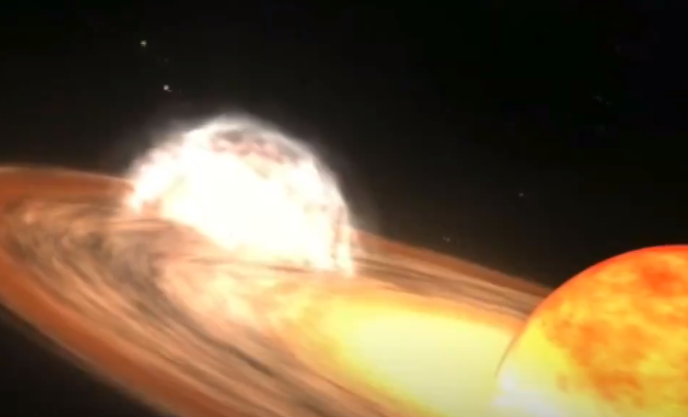It has been many decades since we all witnessed such an event. Well it is now expected. Can happen any day… and yes, it is a remarkable celestial event, a nova explosion last witnessed in 1948, is set to dazzle stargazers once again. This rare occurrence, anticipated to take place within the next few months, could potentially happen by September 2024, according to researchers. The event involves a binary star system, approximately 3,000 light-years away in the constellation of the Northern Crown, known as the “Blaze Star” or T Coronae Borealis.
The system comprises a red giant and a white dwarf star. These two celestial bodies are bound by gravity and orbit around a common center of mass. In this particular system, the red giant is gradually being stripped of its hydrogen by the intense gravitational pull of its denser, white dwarf companion. As hydrogen accumulates on the surface of the white dwarf, it leads to a buildup of pressure and heat until it triggers a thermonuclear explosion. This explosive event is what causes the nova, making it visible from Earth as a “new star” in the night sky.
Last week the enlarged coronal sheath around our Sun began to contract creating darkened skies on Thursday. But now it’s growing again. And this cycle, growing and expanding just days apart, is what happens before a star has a nova event. Get the fuck to the New Earth NOW!!! pic.twitter.com/VvEmB5OqmN
— Book of Katherine (@bookofkatherine) June 11, 2024
Such nova events are extraordinary because they occur about once every 80 years with the involved star system. They are usually too faint and distant to be observed clearly with the naked eye. However, this upcoming nova is expected to be exceptionally bright and observable without the need for telescopes, making it an exciting opportunity for both professional astronomers and casual observers.
Rebekah Hounsell, an assistant research scientist at NASA who specializes in nova events, expressed enthusiasm about the educational impact of the upcoming spectacle. “It’s a once-in-a-lifetime event that will create a lot of new astronomers out there, giving young people a cosmic event they can observe for themselves, ask their own questions, and collect their own data,” she said.
Astronomers are expecting a “new star” to appear in the night sky sometime between now and September, according to NASA. The cosmic event, known as a nova, will occur in the Milky Way’s Corona Borealis. https://t.co/6bU8GQACR2 pic.twitter.com/d11Ws8md3s
— Yahoo News (@YahooNews) June 12, 2024
The chief of the Astroparticle Physics Laboratory, Dr. Elizabeth Hays, emphasized the significance of this nova as well.. She noted that because of its proximity and brightness, this event will allow scientists to study the nova in various wavelengths, which could provide valuable insights into the specific processes and structure of such explosions.
This phenomenon not only offers a unique viewing experience but also serves as a practical demonstration of stellar dynamics and the life cycle of stars. The interaction between the red giant and the white natural creates a spectacular outburst, showcasing the raw power of the universe and the scale of astrophysical events.
NEW STAR TO APPEAR IN SKY BEFORE OCTOBER!
NASA describes this as a once in a lifetime event! As a nova explodes in the Corona Borealis, a new star is expected to become visible somewhere between the Hercules and Bootes constellations. pic.twitter.com/4qW8frXu4j
— Black Hat (@HatT0r) June 13, 2024
Key Points:
i. A rare nova event, last seen in 1948, is expected to occur again within the next few months, potentially by September 2024, and will be visible to the naked eye.
ii. The event involves a binary star system known as the “Blaze Star” or T Coronae Borealis, located 3,000 light-years away in the Northern Crown constellation.
iii. This system consists of a red giant and a white dwarf star, where the red giant is stripped of hydrogen by the white dwarf, leading to a thermonuclear explosion visible as a nova.
iv. The upcoming nova is significant because it is bright enough to be seen without telescopes, making it accessible to both amateur stargazers and professional astronomers.
v. NASA researchers emphasize the educational value of the event, as it provides a practical demonstration of stellar dynamics and offers a chance for new scientific insights into such celestial phenomena.
TL Holcomb – Reprinted with permission of Whatfinger News



